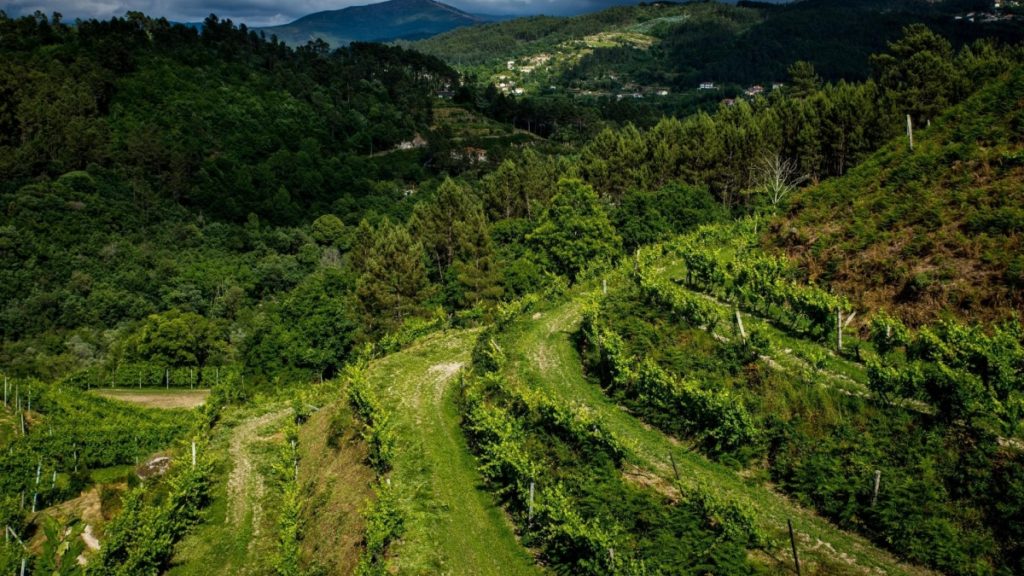
Native vines of the mountains and basins are limited in variety compared to other regions. The main reason for this, is the severe changes in weather and temperatures caused by the great fluctuations in elevation. Plants have to be durable, and I mean tough to hang out in these landscapes.
The Rocky Mountains are the major geological feature of this region that stretches from Alaska, through Canada, and south to Arizona and New Mexico. In between the Mountains, are the Valleys and Basins of the United States and Canada and they can be rich with wildlife. This means plants are needed to feed most of it and to protect most of them.
Locations the the Great Basin in Nevada is often called a cold or high desert because of the low rainfall and cold winters. Lower elevations experience intense heat in the summer while high elevations remain cool. The middle elevations can remain relatively cool in the summer.
Plants of the mountains and basins are either very regional or must be tough enough to handle the weather extremes. This goes for native vines too. Most native landscapes will offer up at least one species of vining plant as they offer food, protection and nesting sights.
Some like Honeysuckle will offer nectar rich flowers to attract bees, hummingbirds and butterflies and berries for your birds later on. , Wild Grapes and other plants offer berries and fruits for birds and mammals, still others offer attractive seed heads like native clematis.
Here is a list of indigenous vining plants and one or two native to other parts of North American that have slowly crept in or have been introduced to your region like Trumpet Creeper.
Celastrus scandens
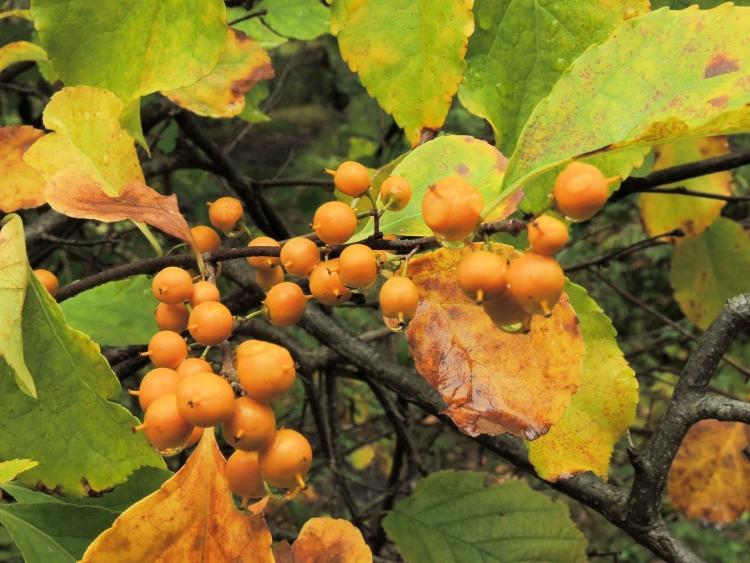
- Common Name: American bittersweet
- Zone: 3 to 8
- Plant Type: Vining
- Family: Celastraceae
- Native Range: North America
- Height: 15 to 20 feet
- Spread: 3 to 6 feet
- Bloom Time: May – June
- Bloom Color: Greenish-white to yellow
- Sun: Full sun
- Water: Medium
- Maintenance: Low
Do not confuse this American gem with the invasive Oriental Bittersweet (C. orbiculatus ). Bittersweet berries attracts birds and other wildlife and the vining, climbing plants offer protection and nesting. Easily grown in most soils.
Best in lean to average soils with regular moisture in full sun. Lean soils help restrain growth. Will grow in part shade, but needs full sun for best flowering and subsequent fruit display.
Prune in late winter to early spring. Mature plants require little pruning other than removal of dead or excess growth.
These native are primarily dioecious (separate male and female plants), (although some have a few perfect flowers and newer cultivars are on the market that eliminate the need for male and female plants.)
Female plants need a male pollinator to produce the attractive fruit that is the signature of this vine.
Unfortunately, some nurseries do not sell the vines as male or female (as is commonly done with hollies). Generally one male plant is needed for 6-9 female plants. Female plants may be vegetatively propagated to create more female plants.
Newer cultivars are arriving on the market that have both, male and female flowers for pollination, be sure to ask.
This plant may be grown on structures or allowed to ramble along the ground. It is generally best to avoid growing up small trees or through shrubs because this plant grows rapidly and can girdle trunks and branches causing damage and sometimes death.
American bittersweet is a deciduous twining woody plant that is best known for its showy red berries that brighten up fall and winter landscapes. This species is native to central and eastern North America. It is often seen growing along the ground, over and through low shrubs or circling trees in the wild.
Fruits split open in fall to reveal scarlet fleshy berry-like seeds (arils). Fruits are poisonous if ingested, but are considered to be quite tasty by many birds.
A native plant for woodland gardens, naturalized areas. Provides quick cover for fences, arbors, trellises, posts, walls or other structures in the landscape. Also may be grown along the ground to camouflage rock piles or old tree stumps.
Clematis ligusticifolia Nutt.
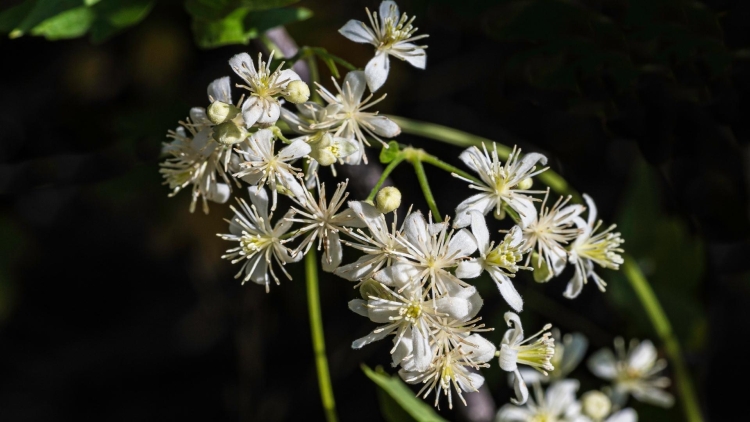
- Common name: Western white clematis, Virgin’s bower, Pepper vine, Hierba de chivo Native Plant.
- Native to Western U. S. and Canada.
- Zone: 5 to 7
- Plant type: Vining
- Family: Ranunculaceae (Buttercup Family)
- Native Range: From the Prairies and West.
- Bloom Color: White
- Height: to 20 feet.
- Sun: Full sun
- Water: Medium to low
- Maintenance: Low
A strong, woody or semi-woody climber to 20 ft. or more. The wide clusters of creamy-white blossoms, from leaf axils on the upper portions of the plant, occur in such profusion they impart a white color to the whole mass of growth.
These are followed by light-catching, silky seed plumes. Deciduous leaves are pinnately compound with 5-7 leaflets.
This species’ traditional name, Pepper Vine, referred to the acrid, peppery taste of the stems and leaves, which
Native Americans chewed as a remedy for colds and sore throats.
It is said that the crushed roots were placed in the nostrils of tired horses to revive them.
Caution is advised: The genus is known to have poisonous species.
Small birds and rodents use the canopy for cover and nesting.
Few pest or problems with this native plant.
Ideal for the xeriscape gardening and erosion control.
Clematis occidentalis
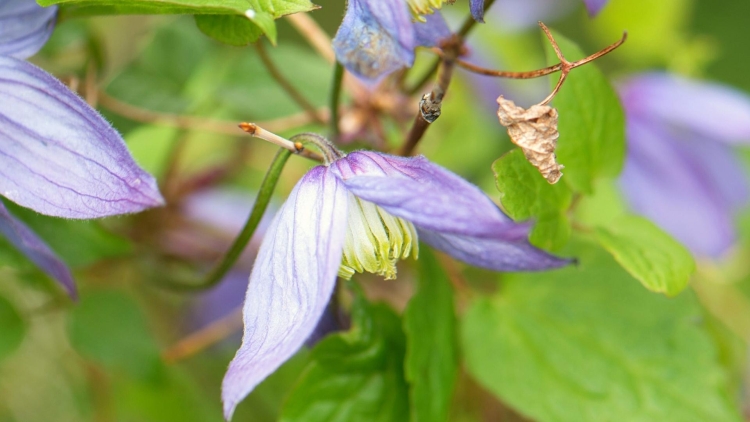
- Common Name: Columbian Virgin’s Bower Clematis. Also called Purple Virgin’s Bower.
- Zone Hardy: Zones 5-7
- Flower: May – July.
- Flower Color: Blue, Red, Purple.
- Bloom time: Apr to Jun.
- Plant Type: Vine.
- Moisture Requirements: Dry, Normal
- Sun: Partial Shade
- Soil Requirements: Sand, Loam
- Natural Habitat(s): Woodland (35-60% cover), Forest Edge, Prairie/Meadow/Field
Found east of the Cascades from British Columbia to northeast Oregon, east to Alberta, Montana, and Colorado.
Virgins Bower is an excellent garden plant for areas east of the Cascades.
Grows in calcareous, rocky areas, including cliffs, ledges, woods, clearings, embankments, and talus slopes.
A slender-stemmed, sometimes creeping, semi-woody perennial that may attain a length of 10-12 ft. The nodding, blue to reddish-purple flowers are solitary on short branches from the axils of three-parted leaves. Flowers are followed by a fragile, plumed seed head.
Attracts wildlife: Birds, Hummingbirds, Butterflies, Bees, and other Showy Insects.
Lonicera ciliosa
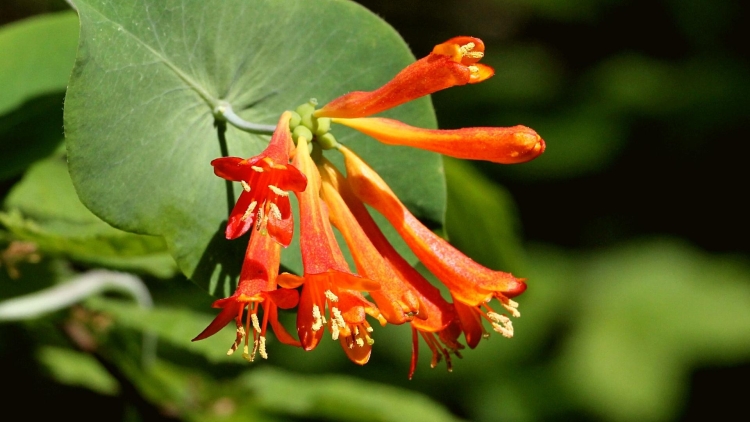
- Common Name: Orange Honeysuckle Vine
- Zone Hardy: Zones, 4 – 9
- Height: 10-20 ft
- Spacing: 6-10 ft
- Spread: 20 ft
- Sun: full/part sun
- Water: Medium
- Foliage: Heart-shaped, gray-green
- Blooms: Coral flowers from June-September
- Fruit: Showy, 1/4 inch red berries are effective through November.
This native looks great climbing up shrubs in your landscape. In addition to attracting hummingbirds, it isn’t aggressive and won’t smother the plant supporting it. It has attractive clusters of orange trumpet shaped flowers that attract hummingbirds. Later in the year, red berries offer food for a variety of birds.
Grows rapidly–creates a dense foliage and trumpet-shaped flame-orange flowers. The Orange Honeysuckle vine blooms steadily from summer to frost and climbs to 20 feet creating a stunning for walls, fence lines. Prefers full to partial sun.
Orange honeysuckle needs a moist, well-drained soil and prefers full sun. It will grow in shade, but will produce fewer flowers. Orange honeysuckle can stand a short–couple of days–with dry soil, but should be watered as soon as possible to make sure that the roots do not dry out.
A fast grower. It does not need a lot of care beyond watering and pruning to keep its growth under control.
For the southern portion of the mountain region, you also have a native honeysuckle.
Lonicera arizonica

- Common Name: Arizona honeysuckle
- Leaves: 3″, oval to elliptical, simple, opposite, finely glandular-hairy; lower leaves on short stalks, upper pairs stalk-less, united at base.
- Flowers: Tubular, with 1 1/2″, red to purplish corollas; in terminal clusters of 2-4; bloom June-July.
- Fruit: Red berries.
- Habitat: Mountain areas, open coniferous woods.
Trailing or climbing vine or shrub. Range Arizona and New Mexico and parts of Utah.
Parthenocissus quinquefolia
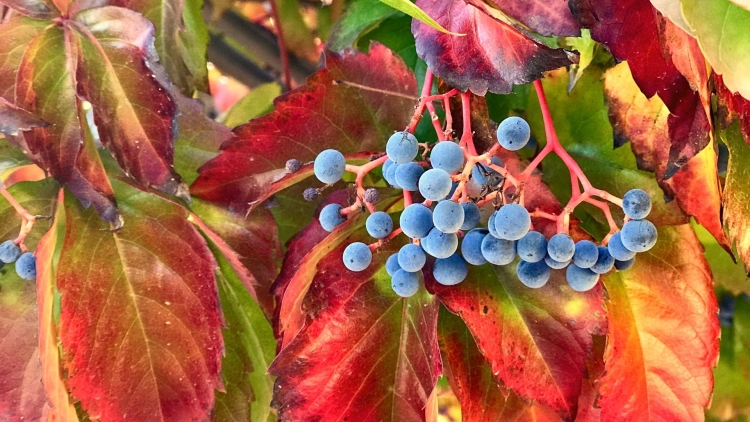
- Common Name: Virginia creeper
- Zone: 3 to 9
- Plant Type: Vine
- Family: Vitaceae
- Native Range: Eastern two-thirds United States and Canada into Mexico, but has found its way westward.
- Height: 30 to 50 feet
- Spread: 5 to 10 feet
- Bloom Time: May – August
- Bloom Color: Greenish white
- Fruit attracts birds, foliage has attractive fall color and fall color and the showy fruit lasts into winter.
Easily grown in average, medium, well-drained soil in full sun to part shade.
Tolerates full shade and a wide range of soil and environmental conditions.
This native vine is a deciduous, woody vine that is found in open areas in ravines, rich woods and valleys. A vigorous tendril-climber that needs no support and typically grows 30-50′. Adheres to flat surfaces (e.g., brick, stone or wood walls) via adhesive disks at the tendril ends.
Compound-palmate leaves (usually 5 leaflets, with each leaflet to 6″ long) emerge purplish in spring, mature to dull green in summer and change to purple to crimson-red in autumn.
Fall color can be quite attractive on this native vine. Clusters of small, greenish-white flowers appear in the upper leaf axils in late spring to early summer, but are generally hidden by the foliage. Flowers give way to dark blue to black berries which are attractive to birds. Closely related to and once included in the genus Ampelopsis.
No serious problems. Mildews, leaf spots, canker and wilt are occasional problems. Also susceptible to a number of insect pests including beetles, scale and leaf hoppers.
Once attached to the side of a building or home, it becomes difficult to remove and will damage painted surfaces and leave residues.
A host plant for Silver-spotted Skipper (Epargyreus clarus) butterfly.
Vitis riparia
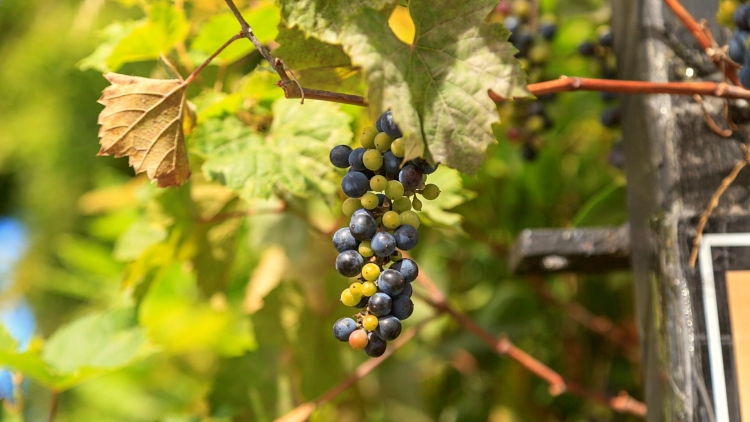
- Common name: River Bank Grape or Frost Grape.
- Sun: Sun to partial shade
- Zone Hardy: Zones 2-9
- Water: Medium.
River Grape is a native American climbing or trailing vine, widely distributed from Quebec to Texas, and Montana to New England. It is long-lived and capable of reaching into the upper canopy of the tallest trees. It produces dark fruit that are appealing to both birds and people, and has been used extensively in commercial viticulture
as grafted rootstock and in hybrid grape breeding programs.
Mature vines have loose, fissured bark, and may attain several inches in diameter. Leaves are alternate, often with opposite tendrils or inflorescences, coarsely toothed, 5–25 cm (2–10in) long and 5–20 cm (2–8in) broad, sometimes with sparse hairs on the underside of veins.
In the wild, the plant thrives along exposed areas with good sun exposure and adequate soil moisture, such as riverbanks, forest clearings, fence lines and along road sides. The species has adapted to a variety of soil chemistry.
Fruits, leaves and sap are edible.
For the southern regions of the Mountains and Basins, you also have Vitis arizonica (Arizona grape, canyon grape) as another wild grape to cultivate.
Grape vines offer a great food source for many birds and a wide variety of animals. Wild grapes are also cultivated for personal use as well.
Campsis radicans
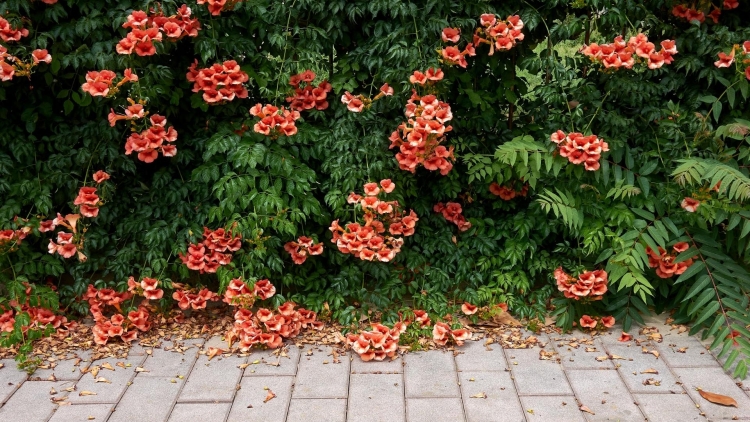
- Common Name: Trumpet Creeper.
- Zone hardy from zones 4-9.
- Medium water and high in maintenance.
This native can grow to 40 feet and does well in full sun to partial shade. More sun, more blooms.
A native of the eastern half of our continent, it has found its way to many Mountain and Basin gardens as well as roadsides and open fields.
A great flower for attracting hummingbirds. However, give this plant lots of room to grow. Trumpet creeper will climb almost anything and can tear siding from your house or barns.
Summary
If you have open fields and natural areas, you may look into some of the various Smilax (Greenbrier) species native to your regions. Greenbriers may not be the most attractive plants or vines, but the thick vining habit and fruits are ideal for food and protection for birds and small mammals.
Some native vines have found their way into many yards throughout North America. Going native is always best. However, going with vines that are regionally native you can never go wrong.
You may also check with neighboring regions where certain plants may cross regions or grow well in your location.
